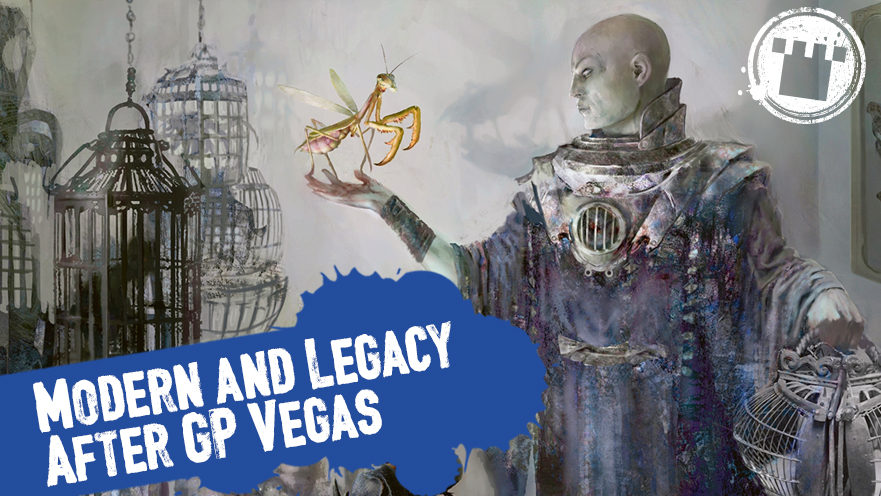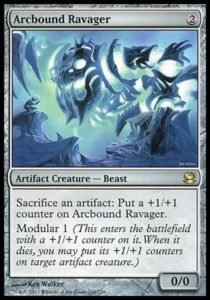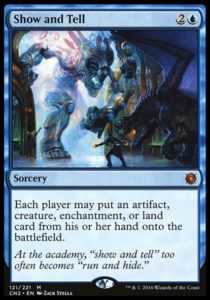Grand Prix Vegas was a whirlwind of a weekend, so much so that it’s taken me a week to gather my wits and start analyzing the results. Modern was particularly interesting, as many players prepared to take down the big bad wolf of the format, Grixis Death’s Shadow. Contenders prepared a variety of strategies to attack the expected metagame.
One of the most successful strategies to come forward was Affinity, which ended up taking down the tournament. Affinity’s quick starts and big swings can get underneath Death’s Shadow‘s countermagic, and many Death’s Shadow players didn’t expect such a high Affinity turnout, so their sideboards were woefully unprepared to fight the machine uprising.
Other successful Death’s Shadow counter-strategies include Burn, which saw four copies in the Top 32 and was successful in pressuring low life totals. Various creature-based aggro decks also took advantage of being able to get underneath Death’s Shadow, with Zoo, Faeries, Humans and Counters Company all making appearances in the Top 32.
Two very different styles of Hatebears also found their way into the Top 8. Craig Wescoe wielded a Green-White list specifically tuned to beat Death’s Shadow with four Mirran Crusaders in the main deck, while Theau Mery’s Mono-White list focused on taking advantage of enter-the-battlefield effects with four Flickerwisps and four Restoration Angels. Both plans utilize Leonin Arbiter in conjunction with Ghost Quarter and Path to Exile to restrict opponents’ access to mana, and with the Grixis Death’s Shadow lists running as few as two basic lands, sometimes the Leonin Arbiter isn’t even necessary.
Eldrazi Tron, a deck that was viewed as a strong contender coming into Grand Prix Vegas, saw two copies in the Top 32 (as well as a copy of Bant Eldrazi, piloted by Martin Juza). One of the main advantages of playing Eldrazi Tron is the ability to run out an early Chalice of the Void, a prison piece that negates much of the power of Death’s Shadow. The ability to pick apart opponents’ hands with Thought-Knot Seer while going over the top with Reality Smasher usually provides a clock that is hard for opponents to match. If opponents can deal with early threats, however, Eldrazi Tron is left relying on its top-decks, with no way to ramp into more pressure.
All these strategies proved successful in Vegas, with no copies of Death’s Shadow making their way into the Top 8. The Modern metagame continues to support Death’s Shadow and the decks that beat it, but I’m curious to see what will happen next. Grixis Death’s Shadow can run up to four Kolaghan’s Commands in the main deck or sideboard if they expect a great deal of Affinity, and some Esper lists have been popping up online with Lingering Souls for the mirror and Path to Exile for opposing Tasigurs and Mirran Crusaders. I believe that Death’s Shadow decks will continue to have the tools to combat whatever strategies pop up to oppose them, but am excited to see if a deck such as Burn or Affinity (or some other counter-strategy) can successfully claim the title of Best Deck.
Legacy
In Legacy, the banning of Sensei’s Divining Top opened the door for many strategies that had previously been pushed out of the format. Delver lists were some of the clearest winners, with three Grixis Delver decks and one U/R Delver list in the Top 16 at GP Vegas. A Temur Delver list also made Top 8, featuring a mainstay of Legacy past with Nimble Mongoose. Interestingly, both flavors of Delver featured main deck Stifle, a card that had all but disappeared from lists.
A few “fair” control decks also emerged to replace the Miracles lists in this new meta. A couple W/U Control lists featuring iconic creatures such as True-Name Nemesis, Snapcaster Mage, and Stoneforge Mystic (with her buddies Umezawa’s Jitte and Batterskull) found their way into the Top 16, as well as Four-Color and Sultai Control lists with our friend Leovold (the only difference in the two lists being a red splash for Lightning Bolt and Kolaghan’s Command).
Another big winner in the banning of Sensei’s Divining Top was Lands. Lands decks are generally favored against a field of fair decks, but tend to struggle against combo-oriented strategies. With more control and creature-based strategies cropping up, it’s no surprise that two Lands players found their way into the Top 16.
There was also a fair amount of Sneak and Show – a powerful engine that can run out an Emrakul as early as turn one by ramping out either Show and Tell or Sneak Attack, usually with Force of Will backup. These lists prey on opponents with minimal interaction, and have enough powerful top-decks that they are usually still able to present threats when a game goes long, even if their hand has been picked apart in the early game. Sneak and Show decks are among the few that can run Blood Moon in the board to lock opponents with greedy mana bases out of the game. Interestingly, only one of the two decks in our Top 16 was running Omniscience, a card that can counteract post-board creature hate such as Containment Priest and Gilded Drake.
Two Stoneblade lists round out the Top 16: a straightforward W/U list and a deck featuring a spicy red splash for an Izzet Staticaster, Pyroblast, and Red Elemental Blast out of the sideboard! Both lists featured one or two Council’s Judgment in the main deck, an interesting addition that can answer anything from an opposing Jace, the Mind Sculptor to True-Name Nemesis.
The only copy of Death & Taxes in the Top 8 ended up taking down the tournament in the hands of Andrew Calderon. With one Spirit of the Labyrinth and two Mirran Crusaders, this deck seems to have identified its most problematic match-ups and formulated a plan of attack. Spirit of the Labyrinth usually comes in against blue-based combo decks such as Storm and Sneak and Show, and Mirran Crusader shores up creature-based match-ups, able to effectively block or attack through opposing Tarmogoyfs or Gurmag Anglers. Equipped with a Sword of Fire and Ice or an Umezawa’s Jitte, this double-striking creature is practically unstoppable.
A few archetypes were noticeably absent at the top tables, including B/R Reanimator – a glass cannon strategy that was a popular choice for many pro players – new Miracles lists that replaced Sensei’s Divining Top with Portent, and Storm variants. Reanimator can easily steal games, but I heard many players comment on how common it was at the x-3 and x-4 tables, due to its inability to provide redundancy against interaction. Similarly, Storm has difficulty comboing through multiple pieces of hate, and it had a particularly rough time in Vegas, with Grixis Delver running rampant and many decks devoting sideboard slots to combo interruption. Storm and Miracles are also some of the most mentally taxing decks to choose for a fifteen-round tournament, so we should also take player fatigue into account when analyzing tournament results.
With less than a handful of premier Legacy tournaments each year, Legacy remains the wild west of Magic: the Gathering. However, I believe the results from one of the largest Legacy tournaments of the year provide some insight into how this format has evolved since the Top ban, and how it will continue to evolve. Fair decks such as Delver and Stoneblade have risen to the top, but combo and control decks such as Lands and Sneak and Show will continue to work to keep them in check.

A Spike at heart, Chantelle spends her free time prepping for tournaments, working toward the ever-elusive Mythic Championship, and championing other competitive ladies. She’s a combo aficionado and seasoned aggro deck player, and Standard and Modern are her preferred formats. Growing and improving as a player, both technically and in her mental game, are of the utmost importance to her.



